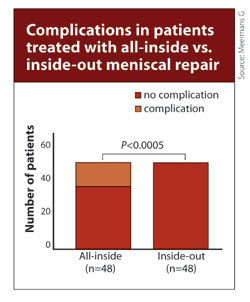Long-term inside-out meniscal suturing results prove better than all-inside repairs
All complications reported in a 96-patient comparative study occurred in the all-inside group.
Patients with meniscal injuries repaired with an inside-out or all-inside arthroscopic technique can expect 75% overall long-term clinical success rates, but the inside-out repair provides a better chance of a successful outcome, Belgian investigators found from their matched cohort study.
“In our hands, the inside-out technique had a better chance of success compared to an all-inside technique,” said Geert Meermans, MD, of Berchem, Belgium, who presented results of the study at the 2010 Annual Meeting of the American Academy of Orthopaedic Surgeons.
Results were even better in patients who had a concomitant ACL tear treated at the same time and in those whose meniscal repairs were performed by 6 weeks post-injury, he said.
Meermans and colleagues used a first-generation device, the Biofix Arrow implant (BIONX Implants, Ltd., Tampere, Finland), for the all-inside technique and a suture mattress technique for the inside-out technique.
“We saw less complications with the inside-out technique,” Meermans noted.

Database study
Using a medical database, Meermans and colleagues reviewed records for 112 meniscal repairs in patients with meniscal injury, matching 96 of them according to associated ACL repair, time from injury to surgery, zone of the meniscal lesion, their age and gender.
In all, 48 patients having an all- inside meniscal repair were matched to 48 patients with an inside-out repair. In each group 38 patients had an associated ACL injury, 35 patients underwent surgery within 6 weeks, 12 patients’ injuries were within the red-red zone, and 33 patients were men
In the all-inside group, mean age was significantly less by at least 3 years (P=.017).
Long-term follow-up
Postoperative rehabilitation was identical and consisted of 1 week of protected weightbearing in all patients. Flexion greater than 90· was prohibited for 6 weeks and squatting was prohibited for 6 months.
The patients’ mean postoperative follow-up was 79 months.
With conflicting biomechanical data available concerning using sutures for inside-out and bioabsorbable implants for all-inside arthroscopic repairs, these investigators found good to excellent short-term results with both techniques.
“All the complications were in the all-inside group, so again a significant difference between the two groups,” Meermans said. The complications included one patient with septic arthritis and two lost Biofix implants. Nine patients developed a marked extension deficit, which successfully resolved with physical therapy, he noted.
In their abstract, Meermans and colleagues said that they hoped with this study to detect any differences in outcome at long-term follow-up. – by Susan M. Rapp
Reference:
- Meermans G, Tengrootenhuysen M, Van Damme G, et al. Arthroscopic meniscal repair: All-inside compared with inside-out suturing at 6 years of follow-up. Paper #571. Presented at the 2010 Annual Meeting of the American Academy of Orthopaedic Surgeons. March 9-13, 2010. New Orleans.
- Geert Meermans, MD, can be reached at geertmeermans@hotmail.com.
It has already been shown that suturing a meniscal tear is biomechanically stronger than repair with all-inside devices, and this well-performed retrospective study shows that this also has clinical implications at long-term follow-up. The take home message is that a meniscus that is amenable to repair should undergo this procedure within 6 weeks, and that the clinical outcome is significantly better if patients have an associated ACL rupture.
– Fredrik Almqvist, MD, PhD
Professor,
Department of Orthopaedic Surgery and Traumatology
Ghent University
Hospital
Ghent, Belgium
